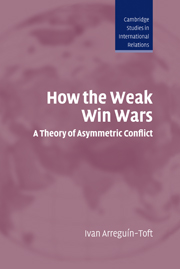Book contents
- Frontmatter
- Contents
- List of figures
- Preface
- Acknowledgments
- List of abbreviations
- 1 Introduction
- 2 Explaining asymmetric conflict outcomes
- 3 Russia in the Caucasus: the Murid War, 1830–1859
- 4 Britain in Orange Free State and Transvaal: the South African War, 1899–1902
- 5 Italy in Ethiopia: the Italo-Ethiopian War, 1935–1940
- 6 The United States in Vietnam: the Vietnam War, 1965–1973
- 7 The USSR in Afghanistan: the Afghan Civil War, 1979–1989
- 8 Conclusion
- Appendix
- References
- Index
- CAMBRIDGE STUDIES IN INTERNATIONAL RELATIONS
5 - Italy in Ethiopia: the Italo-Ethiopian War, 1935–1940
Published online by Cambridge University Press: 22 August 2009
- Frontmatter
- Contents
- List of figures
- Preface
- Acknowledgments
- List of abbreviations
- 1 Introduction
- 2 Explaining asymmetric conflict outcomes
- 3 Russia in the Caucasus: the Murid War, 1830–1859
- 4 Britain in Orange Free State and Transvaal: the South African War, 1899–1902
- 5 Italy in Ethiopia: the Italo-Ethiopian War, 1935–1940
- 6 The United States in Vietnam: the Vietnam War, 1965–1973
- 7 The USSR in Afghanistan: the Afghan Civil War, 1979–1989
- 8 Conclusion
- Appendix
- References
- Index
- CAMBRIDGE STUDIES IN INTERNATIONAL RELATIONS
Summary
We are valiant formations
Of indomitable warriors
Carrying the flags
Into Eastern Africa.
The symbol of glory,
Of peace and civilization
Will be made to shine once more
By the Italic Victory …
Slavery and barbarity
Are doomed to vanish
The very moment
The Roman eagles appear …
From an Italian marching song in the Abyssinian campaignWe flung ourselves on the machine-gun nests to clear them out, we hurled ourselves against the enemy artillery. We held firm against their bombs and their containers of mustard gas. We put their tanks out of action with our bare hands. We cannot reproach ourselves with any taint of cowardice. But against the invisible rain of deadly gas that splashed down on our hands, our faces, we could do nothing. Yet I say again that we have no cause to be ashamed: we could not “kill” this rain.
Haile SelassieThe war between fascist Italy and Ethiopia began on 2 October 1935. Italy was the strong actor by a wide margin. It was a sharp conventional engagement between a well-armed and well-supplied yet poorly led Italian army, and the poorly armed and poorly supplied Ethiopian army. By May of 1936, the emperor of Ethiopia, Haile Selassie, had fled, and the Italians marched triumphantly into Addis Ababa, the capital. Yet the war did not then end. It continued as a guerrilla war from 1936 to 1940, when Britain joined the fight.
- Type
- Chapter
- Information
- How the Weak Win WarsA Theory of Asymmetric Conflict, pp. 109 - 143Publisher: Cambridge University PressPrint publication year: 2005



